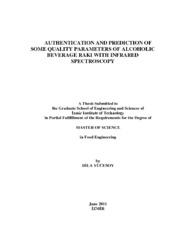Please use this identifier to cite or link to this item:
https://hdl.handle.net/11147/3099Full metadata record
| DC Field | Value | Language |
|---|---|---|
| dc.contributor.advisor | Özen, Banu | en |
| dc.contributor.author | Yücesoy, Dila | - |
| dc.date.accessioned | 2014-07-22T13:50:51Z | - |
| dc.date.available | 2014-07-22T13:50:51Z | - |
| dc.date.issued | 2011 | en |
| dc.identifier.uri | http://hdl.handle.net/11147/3099 | - |
| dc.description | Thesis (Master)--Izmir Institute of Technology, Food Engineering, Izmir, 2011 | en |
| dc.description | Includes bibliographical references (leaves: 53-63) | en |
| dc.description | Text in English; Abstract: Turkish and English | en |
| dc.description | x, 63 leaves | en |
| dc.description.abstract | Mid-infrared spectra of thirty- two Rakı samples of different brands, two types of Ouzo were collected and several chemical parameters were measured with analytical and instrumental methods. Moreover, Rakı samples were adulterated with methanol at 0.5-10% (vol/vol) and IR spectra were also obtained. Aims of this study are to classify Rakı samples according to raw material of Rakı and processing type, to predict some quality parameters of Rakı from IR spectra and also to detect adulteration of methanol in pure Rakı by using Fourier transform infrared spectroscopy in association with multivariate chemometric techniques and SIMCA. All samples were used to classify with respect to grape types (fresh or dried), raw material (only suma or suma and ethanol) and production process (double or triple distilled) by chemometric models. No clear classification could be found as parameters investigated because of predominant of alcoholic content in Rakı. In quantification analysis; pH, brix, electrical conductivity, total phenol and sugar content were determined with analytical reference methods for pure samples, then PLS were used to construct models to establish relationships between reference methods and FTIR spectra and to predict these quality parameters from spectral data. After PLS regression, highly good models were developed for brix and sugar. For adulteration analysis, six different Rakı samples were adulterated. First, PCA was used to detect Rakı samples adulterated with methanol. Then, PLS multivariate calibration model was constructed to determine the adulterant methanol content in Rakı . Consequently, successful results were obtained for detection of methanol in Raıı samples. | en |
| dc.language.iso | en | en_US |
| dc.publisher | Izmir Institute of Technology | en |
| dc.rights | info:eu-repo/semantics/openAccess | en_US |
| dc.subject.lcsh | Alcoholic beverages | en |
| dc.subject.lcsh | Alcohol--Analysis--Instruments--Testing | en |
| dc.title | Authentication and prediction of some quality parameters of alcoholic beverage rakı with infrared spectroscopy | en_US |
| dc.type | Master Thesis | en_US |
| dc.institutionauthor | Yücesoy, Dila | - |
| dc.department | Thesis (Master)--İzmir Institute of Technology, Food Engineering | en_US |
| dc.relation.publicationcategory | Tez | en_US |
| item.languageiso639-1 | en | - |
| item.fulltext | With Fulltext | - |
| item.openairecristype | http://purl.org/coar/resource_type/c_18cf | - |
| item.openairetype | Master Thesis | - |
| item.grantfulltext | open | - |
| item.cerifentitytype | Publications | - |
| Appears in Collections: | Master Degree / Yüksek Lisans Tezleri | |
Files in This Item:
| File | Description | Size | Format | |
|---|---|---|---|---|
| T000912.pdf | MasterThesis | 1.72 MB | Adobe PDF |  View/Open |
CORE Recommender
Page view(s)
148
checked on Jul 22, 2024
Download(s)
180
checked on Jul 22, 2024
Google ScholarTM
Check
Items in GCRIS Repository are protected by copyright, with all rights reserved, unless otherwise indicated.